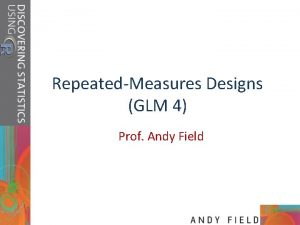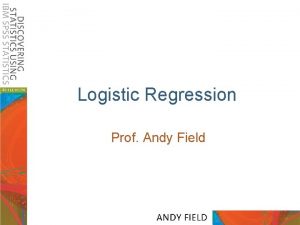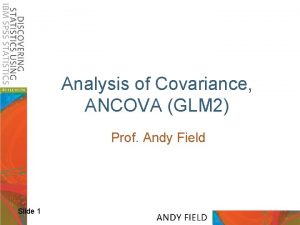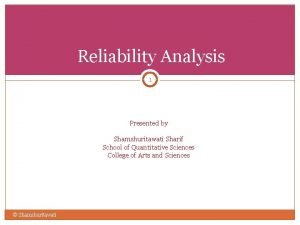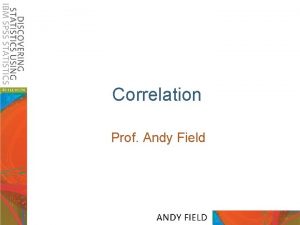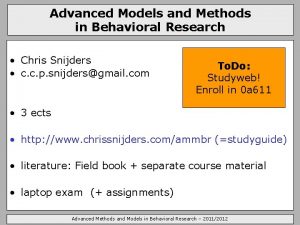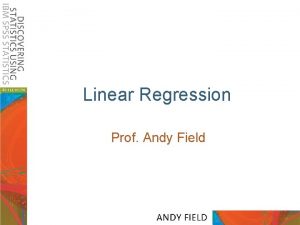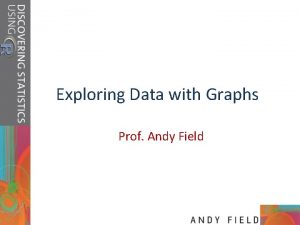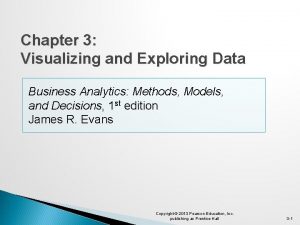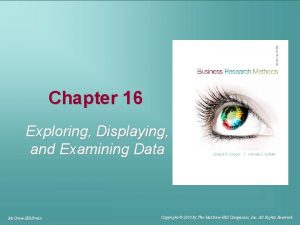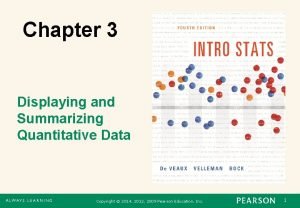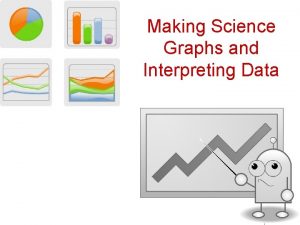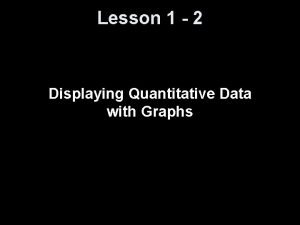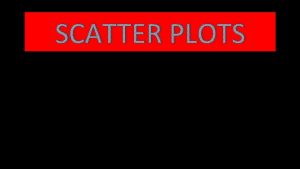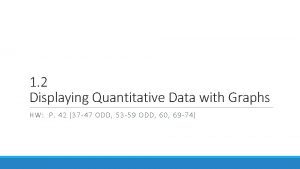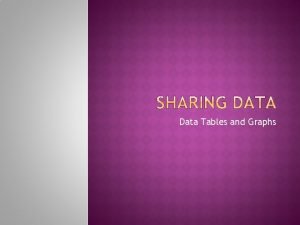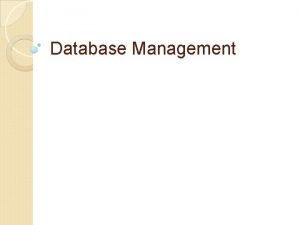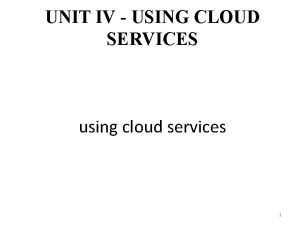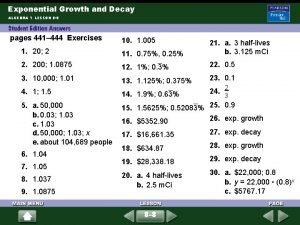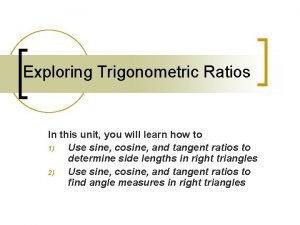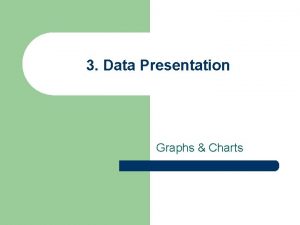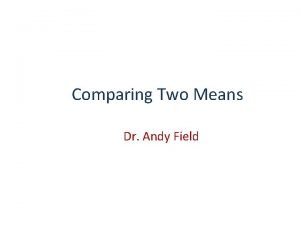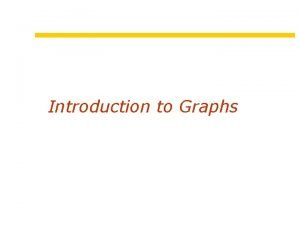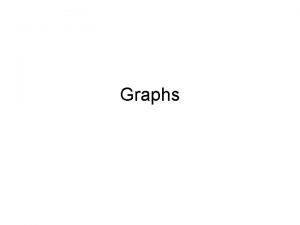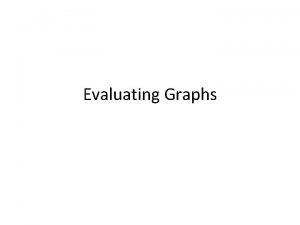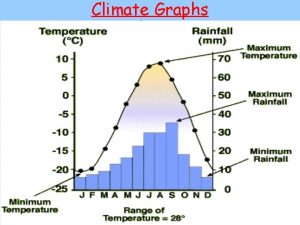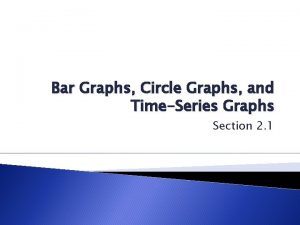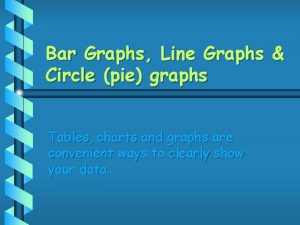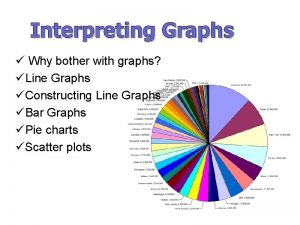Exploring Data with Graphs Prof Andy Field Aims














































- Slides: 46

Exploring Data with Graphs Prof. Andy Field

Aims • How to present data clearly • Introduce ggplot 2 • Graphs – Scatterplots – Histograms – Boxplots – Error bar charts – Line graphs

The Art of Presenting Data • Graphs should (Tufte, 2001): – Show the data. – Induce the reader to think about the data being presented (rather than some other aspect of the graph). – Avoid distorting the data. – Present many numbers with minimum ink. – Make large data sets (assuming you have one) coherent. – Encourage the reader to compare different pieces of data. – Reveal data.

Why Is This Graph Bad?

Why Is This Graph Better?

Deceiving the Reader Two graphs about cheese

ggplot 2 In ggplot 2 a plot is made up of layers.

The anatomy of a graph

Specifying aesthetics in ggplot 2

Scatterplots: Example • Anxiety and exam performance • Participants: – 103 students • Measures – Time spent revising (hours) – Exam performance (%) – Exam Anxiety (the EAQ, score out of 100) – Gender

Simple Scatterplot scatter <- ggplot(exam. Data, aes(Anxiety, Exam)) scatter + geom_point() + geom_smooth() labs(x = "Exam Anxiety", y = "Exam Performance %")

Simple Scatterplot of exam anxiety against exam performance with a smoother added

Simple Scatterplot With Regression Line scatter <- ggplot(exam. Data, aes(Anxiety, Exam)) scatter + geom_point() + geom_smooth(method = "lm", colour = "Red")+ labs(x = "Exam Anxiety", y = "Exam Performance %")

Simple Scatterplot A simple scatterplot with a regression line added

Grouped Scatterplot scatter <- ggplot(exam. Data, aes(Anxiety, Exam, colour = Gender)) scatter + geom_point() + geom_smooth(method = "lm", aes(fill = Gender), alpha = 0. 1) + labs(x = "Exam Anxiety", y = "Exam Performance %", colour = "Gender")

Grouped Scatterplot of exam anxiety and exam performance split by gender

Histograms: Spotting Obvious Mistakes • Histograms plot: – The score (x-axis) – The frequency (y-axis) • Histograms help us to identify: – The shape of the distribution • Skew • Kurtosis • Spread or variation in scores – Unusual scores

Histograms: Example • A biologist was worried about the potential health effects of music festivals. • Download Music Festival • Measured the hygiene of 810 concert-goers over the three days of the festival. • Hygiene was measured using a standardized technique : – Score ranged from 0 to 4 • 0 = you smell like a corpse rotting up a skunk’s arse • 4 = you smell of sweet roses on a fresh spring day

Histogram of Hygiene Scores for Day 1 • Create the plot object: festival. Histogram <- ggplot(festival. Data, aes(day 1)) + opts(legend. position = "none") • Add the graphical layer: festival. Histogram + geom_histogram(binwidth = 0. 4 ) + labs(x = "Hygiene (Day 1 of Festival)", y = "Frequency")

The Resulting Histogram

Boxplots (Box-Whisker Diagrams) • Boxplots are made up of a box and two whiskers. • The box shows: – The median – The upper and lower quartile – The limits within which the middle 50% of scores lie. • The whiskers show – The range of scores – The limits within which the top and bottom 25% of scores lie

Boxplots (Box-Whisker Diagrams) • To make a boxplot of the day 1 hygiene scores for males and females, set the variable Gender as an aesthetic. • Specify Gender to be plotted on the x-axis, and hygiene scores (day 1) to be the variable plotted on the y-axis: festival. Boxplot <- ggplot(festival. Data, aes(gender, day 1)) festival. Boxplot + geom_boxplot() + labs(x = "Gender", y = "Hygiene (Day 1 of Festival)")

The Boxplot

What Does The Boxplot Show?

Error Bar Charts • The bar (usually) shows the mean score • The error bar sticks out from the bar like a whisker. • The error bar displays the precision of the mean in one of three ways: – The confidence interval (usually 95%) – The standard deviation – The standard error of the mean

Bar Chart: One Independent Variable • Is there such a thing as a ‘chick flick’? • Participants: – 20 men – 20 women • Half of each sample saw one of two films: – A ‘chick flick’ (Bridget Jones’s Diary), – Control (Memento). • Outcome measure – Physiological arousal as an indicator of how much they enjoyed the film.

Bar Chart: One Independent Variable • To plot the mean arousal score (y-axis) for each film (x-axis) first create the plot object: bar <- ggplot(chick. Flick, aes(film, arousal)) • To add the mean, displayed as bars, we can add this as a layer to bar using the stat_summary() function: bar + stat_summary(fun. y = mean, geom = "bar", fill = "White", colour = "Black"

Bar Chart: One Independent Variable • To add error bars, add these as a layer using stat_summary(): + stat_summary(fun. data = mean_cl_normal, geom = "pointrange") • Finally, let’s add some nice labels to the graph using lab(): + labs(x = "Film", y = "Mean Arousal")

Bar Chart: One Independent Variable • If we put all of these commands together we can create the graph by executing the following command: bar + stat_summary(fun. y = mean, geom = "bar", fill = "White", colour = "Black") + stat_summary(fun. data = mean_cl_normal, geom = "pointrange") + labs(x = "Film", y = "Mean Arousal")

Bar Chart: One Independent Variable

Bar Chart: Two Independent Variables bar <- ggplot(chick. Flick, aes(film, arousal, fill = gender)) bar + stat_summary(fun. y = mean, geom = "bar", position="dodge") + stat_summary(fun. data = mean_cl_normal, geom = "errorbar", position = position_dodge(width = 0. 90), width = 0. 2) + labs(x = "Film", y = "Mean Arousal", fill = "Gender")

Bar Chart: Two Independent Variables

Bar Chart: Two Independent Variables bar <- ggplot(chick. Flick, aes(film, arousal, fill = film)) bar + stat_summary(fun. y = mean, geom = "bar") + stat_summary(fun. data = mean_cl_normal, geom = "errorbar", width = 0. 2) + facet_wrap( ~ gender) + labs(x = "Film", y = "Mean Arousal") + opts(legend. position = "none")

Bar Chart: Two Independent Variables

Line Graphs: One Independent Variable • How to cure hiccups? • Participants: – 15 hiccup sufferers • Each tries four interventions (in random order): – – Baseline Tongue-pulling manoeuvres Massage of the carotid artery Digital rectal massage • Outcome measure – The number of hiccups in the minute after each procedure


Line Graphs: One Independent Variable • These data are in the wrong format for ggplot 2 to use. • We need all of the scores stacked up in a single column and then another variable that specifies the type of intervention. • We can rearrange the data as follows: hiccups<-stack(hiccups. Data) names(hiccups)<-c("Hiccups", "Intervention")


Line Graphs: One Independent Variable • To plot a categorical variable in ggplot() it needs to be recognized as a factor: Hiccups$Intervention_Factor <factor(hiccups$Intervention, levels = hiccups$Intervention)

Line Graphs: One Independent Variable • We can then create the line graph by executing the following commands: line <- ggplot(hiccups, aes(Intervention_Factor, Hiccups)) line + stat_summary(fun. y = mean, geom = "point") + stat_summary(fun. y = mean, geom = "line", aes(group = 1), colour = "Red", linetype = "dashed") + stat_summary(fun. data = mean_cl_boot, geom = "errorbar", width = 0. 2) + labs(x = "Intervention", y = "Mean Number of Hiccups")

Line chart with error bars of the mean number of hiccups at baseline and after various interventions

Line Graphs for Several Independent Variables • Is text-messaging bad for your grammar? • Participants: – 50 children • Children split into two groups: – Text-messaging allowed – Text-messaging forbidden • Each child measures at two points in time: – Baseline – 6 months later • Outcome measure – Percentage score on a grammar test


Line Graphs for Several Independent Variables • These data are again in ‘wide’ format but we need the data to be in ‘long’ format: text. Messages<- melt(text. Data, id = "Group”, measured = c("Baseline", "Six_months”)) names(text. Messages)<-c( “Group”, “Time”, "Grammar_Score”) • We can now change the newly created variable Time so that it is treated as a factor, and provide labels for the two levels of this variable: text. Messages$Time<-factor(text. Messages$Time, labels = c("Baseline", "6 Months"))

Line Graphs for Several Independent Variables line <- ggplot(text. Messages, aes(Time, Grammar_Score, colour = Group)) line + stat_summary(fun. y = mean, geom = "point") + stat_summary(fun. y = mean, geom = "line", aes(group = Group)) + stat_summary(fun. data = mean_cl_boot, geom = "errorbar", width = 0. 2) + labs(x = "Time", y = "Mean Grammar Score", colour = "Group")

Error line graph of the mean grammar score over six months in children who were allowed to text-message versus those who were forbidden
 Exploring quadratic functions
Exploring quadratic functions State testing and testability tips
State testing and testability tips Graphs that compare distance and time are called
Graphs that compare distance and time are called Graphs that enlighten and graphs that deceive
Graphs that enlighten and graphs that deceive 5-3 practice polynomial functions
5-3 practice polynomial functions Andy field repeated measures anova
Andy field repeated measures anova Andy field moderation
Andy field moderation Andy field logistic regression
Andy field logistic regression Andy field factor analysis
Andy field factor analysis Andy field decision tree
Andy field decision tree Ancova
Ancova Shamshuritawati sharif
Shamshuritawati sharif Andy field
Andy field Andy field
Andy field Andy field
Andy field Andy field
Andy field Andy field
Andy field Visualizing and exploring data in business analytics
Visualizing and exploring data in business analytics Data preparing exploring examining and displaying
Data preparing exploring examining and displaying Chapter 3 displaying and summarizing quantitative data
Chapter 3 displaying and summarizing quantitative data Magnitude of magnetic force
Magnitude of magnetic force Individual differences in second language learning
Individual differences in second language learning Field dependent vs field independent
Field dependent vs field independent Distinguish between magnetic and nonmagnetic materials
Distinguish between magnetic and nonmagnetic materials Waveguide cutoff frequency
Waveguide cutoff frequency Database field types and field properties
Database field types and field properties Field dependent and field independent
Field dependent and field independent Difference between electric field and magnetic field
Difference between electric field and magnetic field Interpreting graphs science
Interpreting graphs science Quantitative data graphs
Quantitative data graphs Scatter plot bivariate data
Scatter plot bivariate data Displaying quantitative data
Displaying quantitative data Data tables and graphs
Data tables and graphs Afatds
Afatds Data field
Data field Data field
Data field Verifies that a required field contains data
Verifies that a required field contains data Why did europeans begin to explore
Why did europeans begin to explore Exploring online planning and task management
Exploring online planning and task management Lesson 1 exploring conic sections
Lesson 1 exploring conic sections What motivates people to explore
What motivates people to explore Paradox ip exploring tools
Paradox ip exploring tools Section 11-5 linkage and gene maps answer key
Section 11-5 linkage and gene maps answer key Python for informatics
Python for informatics Practice 8-8 exponential growth and decay
Practice 8-8 exponential growth and decay Ratio for sine
Ratio for sine Exploring the water cycle capture sheet answers
Exploring the water cycle capture sheet answers





